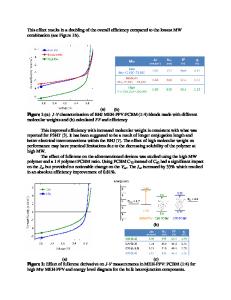Passivation ability of graphene oxide demonstrated by two-different-metal solar cells
- PDF / 817,279 Bytes
- 5 Pages / 595.276 x 793.701 pts Page_size
- 106 Downloads / 325 Views
NANO EXPRESS
Open Access
Passivation ability of graphene oxide demonstrated by two-different-metal solar cells Wen-Tzu Hsu1, Zong-Sian Tsai1, Liang-Chun Chen1, Guan-Yu Chen1, Chun-Chieh Lin2, Mei-Hsin Chen1, Jenn-Ming Song3 and Chu-Hsuan Lin1*
Abstract The study on graphene oxide (GO) grows rapidly in recent years. We find that graphene oxide could act as the passivation material in photovoltaic applications. Graphene oxide has been applied on Si two-different-metal solar cells. The suitable introduction of graphene oxide could result in obvious enhancement on the efficiency. The simple chemical process to deposit graphene oxide makes low thermal budget, large-area deposition, and fast production of surface passivation possible. The different procedures to incorporate graphene oxide in Si two-different-metal solar cells are compared, and 21% enhancement on the efficiency is possible with a suitable deposition method. Keywords: Passivation; Solar cell; Graphene oxide; Two-different-metal; Hummers method
Background Energy from solar cells has been thought as the possible alternative to the traditional fuel energy. In order to compete with the traditional energy, increase on the efficiency of solar cells in a cost-effective way is important. For a solar module with an efficiency of 20%, 1% improvement on efficiency can correspond to 5% reduction in cost. Surface structures [1-3] and passivation [4-7] can be utilized to improve the efficiency. Passivation of bare Si surfaces can be easily achieved with hydrogen termination, alkylation, and so on, but the effect may deteriorate in a certain time [8]. Passivation by dielectric films, such as SiO2, SiNx, and Al2O3 could overcome the stability issue. The high-quality SiO2 is common oxide for surface passivation of Si solar cells. Al2O3 prepared by atomic layer deposition is also used due to its promising ability of passivation for Si, especially for the p-type Si. Since various oxide materials have been used for passivation of solar cells, we would like to investigate the effect of graphene oxide (GO) as the passivation layer. GO is broadly studied after the developing of graphene in recent years [9-11]. The above mentioned oxide passivation films are almost demonstrated in chambers, and * Correspondence: [email protected] 1 Department of Opto-Electronic Engineering, National Dong Hwa University, Hualien, Taiwan Full list of author information is available at the end of the article
GO deposited in chemical solution may be a much simpler method. For the photovoltaic applications, GO has been adopted in organic solar cells as the hole transport layer [12]. We will apply GO to Si solar cells with the purpose of surface passivation. The different procedures to incorporate GO in Si two-different-metal solar cells are compared. To the best of our knowledge, GO has not been utilized on the applications of solar cell passivation. The chemical solution method makes the low thermal budget, large-area deposition, and fast production possible.
Methods A two-different-me
Data Loading...







